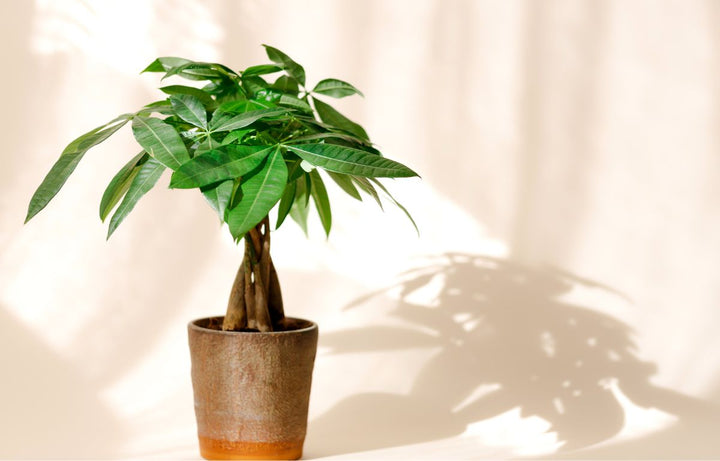
Plant Profile: Money Tree or Guiana Chestnut
Plant Profile: Money Tree or Guiana Chestnut
The Money Tree or Guiana Chestnut, is unique for its attractive braided trunk and lush, green foliage. In addition to its aesthetic appeal, the Money Tree is celebrated in various cultures for its supposed ability to bring good luck and positive energy. Whether you’re looking to add a touch of greenery to your space or attract some good fortune, the Money Tree is a delightful choice.

The Money Tree, scientifically known as Pachira aquatica, is native to the swamps of Central and South America, specifically countries like Mexico, Brazil, and Peru. The plant thrives in wet and humid environments and can grow up to 60 feet in its natural habitat. It gained its nickname 'Money Tree' from a legend about a poor man who prayed for money, found the plant, and made a fortune selling its seeds. Today, the Money Tree is often given as a gift to symbolize good luck and prosperity, especially in East Asian cultures.
Trunk Braiding
When young, flexible Money Tree saplings are carefully intertwined. As the plants mature, the stems thicken and fuse, creating the distinctive braided appearance and becoming one larger plant. This process is primarily done for aesthetic and symbolic reasons, enhancing the plant's visual appeal and marketability. In feng shui, the intertwining trunks symbolize interconnections and good fortune.
Flowering and Chestnut Production
The flowers of the Money Tree are quite unique and distinctive. They are generally small, creamy white to pale yellow in colour, and have a five-petal structure. Each flower typically has a trumpet-like shape with a central pistil surrounded by stamens. The flowers grow in clusters at the ends of branches or along the trunk, depending on the plant's age and growth habit.
Despite being called the Guiana Chestnut, its nuts are not true chestnuts. Instead, the tree produces large, green, oval-shaped seed pods after flowering. These pods contain edible seeds that resemble peanuts in taste and can be enjoyed raw or cooked.
Care and Maintenance Requirements
Light: The Money Tree thrives in bright, indirect light. While it can tolerate low light conditions, too little light can lead to leggy growth and poor health. Avoid placing it in direct sunlight, as this can scorch its leaves.
Watering: Watering the Money Tree correctly is crucial. Overwatering can lead to root rot, a common issue with this plant. Water the plant thoroughly when the top inch of soil feels dry, ensuring excess water drains out of the pot.
Humidity: As a tropical plant, the Money Tree prefers higher humidity levels between 50% and 60%. If you live in a dry climate, consider misting the leaves regularly or placing the plant on a pebble tray filled with water to increase humidity. Group your other houseplants together to create a naturally forming humid microenvironment.
Temperature: The ideal temperature range for a Money Tree is between 18°C to 24°C. It’s important to keep the plant away from cold drafts and sudden temperature changes. Avoid placing your Money Tree near heating vents or air conditioners, which can cause fluctuations in temperature.
Soil and Fertilisation: A well-draining, peat-moss-based soil mix is ideal for the Money Tree. Fertilise your plant monthly during the growing season (spring and summer) with a balanced, water-soluble fertiliser. Reduce fertilisation in autumn and winter when the plant’s growth naturally slows down.

Common Problems and Solutions
Despite being relatively easy to care for, the Money Tree can encounter some problems. Here are common issues and their solutions:
Leggy Growth: Leggy growth is generally caused by insufficient light exposure. Move your Money Tree into a sunnier position or keep your grow lights on for longer. Rotate your plant every week or so to ensure even growth and prevent it from leaning toward the light source.
Yellowing Leaves: Overwatering or poor drainage is a common issue with houseplants. Regularly check the soil moisture and ensure the pot has adequate drainage. Allow the soil to dry out between waterings.
Leaf Drop: Sudden changes in temperature, light, or humidity can cause leaf dropping. Keep the plant in a stable environment with consistent light and temperature. Avoid moving it frequently.
Brown Leaf Tips: Low humidity or over-fertilisation. Increase humidity around the plant and ensure you’re not over-fertilising. Flush the soil with water to remove excess salts if over-fertilisation is suspected.
Pests: The most common pests are spider mites, mealybugs, and scale. Regularly inspect your plant for pests. If detected, treat with insecticidal soap or neem oil. Isolate the affected plant to prevent spreading.
Not Flowering: Money Trees require maturity to flower. If your Money Tree has not yet produced seeds after three to five years, consider adjusting temperature, light exposure, fertilisation, and watering frequency. Suboptimal conditions may hinder flower growth.
The Money Tree, with its rich origins and unique braided trunk, is much more than a simple houseplant. It embodies a blend of beauty, symbolism, and ease of care that makes it a beloved addition to any home or office. By providing the right light, water, and humidity, you can enjoy a thriving Money Tree that not only enhances your decor but also brings a touch of nature’s charm indoors. Whether you’re drawn to its aesthetic appeal or its cultural significance, the Money Tree is a wonderful plant that rewards attentive care with lush growth and, perhaps, a bit of good fortune.
Keen to learn more? Discover more about Devils Ivy here.
